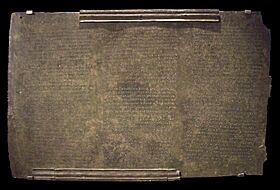Lex Ursonensis facts for kids
Quick facts for kids Lex Ursonensis |
|
|---|---|
| Ley de Urso | |

Epigraphy, legal slab
|
|
| Material | Bronze |
| Long | 92.20 cm |
| Height | 59 cm |
| Width | 3 cm |
| Created | 1st century CE |
| Period/culture | Roman Empire |
| Discovered | 1870-75 Urso, Osuna, Seville |
| Present location | National Archaeological Museum (Madrid) |
| Registration | 16736 |
The Lex Ursonensis was a very important ancient Roman law. It was like the official rulebook for a Roman city called colonia Iulia Genetiva. This city was located at Urso, near Osuna in southern Spain.
This special law was carved onto bronze tablets. These tablets were discovered between 1870 and 1875. The original law had nine tablets. Each tablet had several columns of text. It contained over 140 different sections, called rubricae. Today, only four of these tablets survive. They include sections 61-82, 91-106, and 123-134. You can see these ancient tablets at the National Archaeological Museum of Spain in Madrid.
Contents
What Was the Lex Ursonensis?
The Lex Ursonensis was a founding charter. Think of it as the constitution for a new Roman settlement. It set out all the rules for how the city of Urso would be governed. This included rules for its citizens and how the city would operate.
A City's Rulebook
When the Romans created a new colony, they often gave it a special law. This law helped organize the new city. It covered many things, such as:
- How the city's leaders would be chosen.
- What rights and duties the citizens had.
- How public services would work.
- Rules for daily life and business.
This law made sure that the new colony followed Roman ways. It helped the city become a true part of the Roman Empire.
How Roman Laws Were Made
In ancient Rome, important laws were often approved by the comitium, which was a Roman assembly. This was a gathering of Roman citizens. They would vote on new laws.
The Role of Mark Antony
The Lex Ursonensis was probably suggested by Mark Antony. He was a powerful Roman general and politician. This happened after the assassination of Julius Caesar. Caesar was a very famous Roman leader. After his death, Mark Antony played a big role in Roman politics. He helped establish new colonies and laws like this one.
Discovery and Preservation
The bronze tablets of the Lex Ursonensis were found in the 1870s. Finding them was a huge discovery for historians. They give us a lot of information about Roman life and law.
Where to See the Tablets
Today, the surviving parts of the Lex Ursonensis are kept safely. They are displayed at the National Archaeological Museum of Spain. This museum is located in Madrid. It is a great place to learn about ancient history.
See also
In Spanish: Lex Ursonensis para niños

